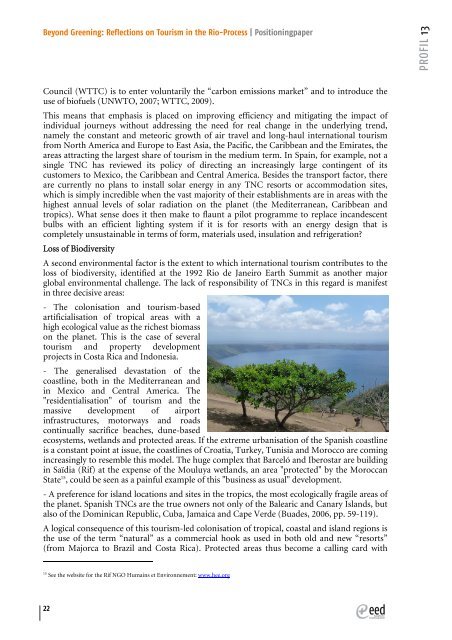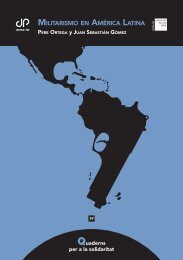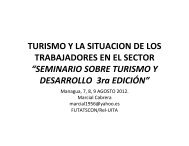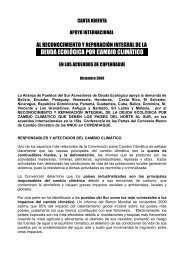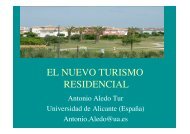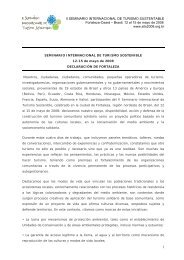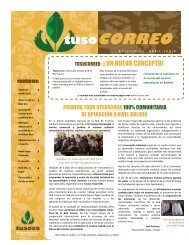<strong>Beyond</strong> <strong>Greening</strong>: Reflections on <strong>Tourism</strong> in the Rio-Process | PositioningpaperCouncil (WTTC) is to enter voluntarily the “carbon emissions market” and to introduce theuse of biofuels (UNWTO, 2007; WTTC, 2009).This means that emphasis is placed on improving efficiency and mitigating the impact ofindividual journeys without addressing the need for real change in the underlying trend,namely the constant and meteoric growth of air travel and long-haul international tourismfrom North America and Europe to East Asia, the Pacific, the Caribbean and the Emirates, theareas attracting the largest share of tourism in the medium term. In Spain, for example, not asingle TNC has reviewed its policy of directing an increasingly large contingent of itscustomers to Mexico, the Caribbean and Central America. Besides the transport factor, thereare currently no plans to install solar energy in any TNC resorts or accommodation sites,which is simply incredible when the vast majority of their establishments are in areas with thehighest annual levels of solar radiation on the planet (the Mediterranean, Caribbean andtropics). What sense does it then make to flaunt a pilot programme to replace incandescentbulbs with an efficient lighting system if it is for resorts with an energy design that iscompletely unsustainable in terms of form, materials used, insulation and refrigeration?Loss of BiodiversityA second environmental factor is the extent to which international tourism contributes to theloss of biodiversity, identified at the 1992 Rio de Janeiro Earth Summit as another majorglobal environmental challenge. The lack of responsibility of TNCs in this regard is manifestin three decisive areas:- The colonisation and tourism-basedartificialisation of tropical areas with ahigh ecological value as the richest biomasson the planet. This is the case of severaltourism and property developmentprojects in Costa Rica and Indonesia.- The generalised devastation of thecoastline, both in the Mediterranean andin Mexico and Central America. The"residentialisation" of tourism and themassive development of airportinfrastructures, motorways and roadscontinually sacrifice beaches, dune-basedecosystems, wetlands and protected areas. If the extreme urbanisation of the Spanish coastlineis a constant point at issue, the coastlines of Croatia, Turkey, Tunisia and Morocco are comingincreasingly to resemble this model. The huge complex that Barceló and Iberostar are buildingin Saïdia (Rif) at the expense of the Mouluya wetlands, an area "protected" by the MoroccanState 15 , could be seen as a painful example of this "business as usual" development.- A preference for island locations and sites in the tropics, the most ecologically fragile areas ofthe planet. Spanish TNCs are the true owners not only of the Balearic and Canary Islands, butalso of the Dominican Republic, Cuba, Jamaica and Cape Verde (Buades, 2006, pp. 59-119).A logical consequence of this tourism-led colonisation of tropical, coastal and island regions isthe use of the term “natural” as a commercial hook as used in both old and new “resorts”(from Majorca to Brazil and Costa Rica). Protected areas thus become a calling card with15See the website for the Rif NGO Humains et Environnement: www.hee.org22
<strong>Beyond</strong> <strong>Greening</strong>: Reflections on <strong>Tourism</strong> in the Rio-Process | Positioningpaperwhich to attract new residential and tourist developments which, once completed, lead to thedisappearance or major deterioration of those same areas 16 . According to the United NationsEnvironment Programme, tourism in the most environmentally threatened areas of the planetwill have doubled in the 1990s (Christ et al, 2003).WaterWater stress always accompanies tourism-led industrialisation. On the one hand, the sector’swater consumption is much higher than the consumption of local residents. For example, atourist consumes 3.8 times more water than a resident in Lanzarote (Canary Islands), and inBarbados this figure can be as much as ten times more (Buades, 2008). Various extravagantuses linked to tourism (such as golf courses, swimming pools and water parks, as well asresidential parks and condo hotels) cause consumption levels to shoot up. A golf course needsas much water per year as a community of eight thousand people (GOB Mallorca, 2000).The majority of the most heavily exploited tourist regions are located in areas where there is awater shortage to begin with or where it becomes scarce due to over-consumption as a resultof tourism and "residentialisation". Whereas in the Mediterranean pressure from tourism andresidential development advocates generating fresh water artificially to sustain growth at anycost (by transferring the problem to the climate, as production dramatically increases CO 2emissions), in the Caribbean and Central America, the dispute over water translates intocitizen-led struggles to defend aquifers from the threat of being privatised and used up bytourism and property development TNCs. The case of the Nimboyore river in the Guanacasteprovince of Costa Rica against hotel and residential projects such as the Sol Meliá at PlayaConchal and Reserva Conchal, or Riu and others at El Coco and Ocotal, is paradigmatic(Ramírez Cover, 2008). 17 Another example is the battle by local people and even institutionsagainst the Riu, Iberostar and Fiesta TNCs in Jamaica over the risks that the TNCs’megaprojects are posing to the supply of water as a common good in regions such as Negril. 18Going beyond the multiplication of “pilot projects”The crucial point is to go beyond the multiplication of “pilot projects” and micro actions in"end of pipeline" measures. TNCs and governments have spent years demonstrating how tosave energy by switching off lights when leaving a room, or by attaching water diffusers tocertain devices. By their very nature, which is often subordinate to the requirements of acompany’s image or brand, the results have been practically irrelevant.The international tourist industry must consider a green reform of its products in order tocreate a positive effect on the environmental balance. Strategic priorities should include:- The "greening" of existing sites and services. TNCs could implement plans to install solarenergy and energy efficiency measures in all their facilities, with the aim of lowering theamount of CO 2 and other greenhouse gas emissions, and to relieve pressure for more fossilfuelor nuclear power plants. At the same time, they should also implement general plans tominimise and reuse water and waste products. Desirable initiatives would include consideringdoing away with golf courses and water parks in the most bio-climatically fragile areas, such asthe Mediterranean and the Caribbean. The industry could also implement minimum wasteprogrammes by drastically reducing the use of plastics and non-recyclable materials.16See www.salvemmallorca.org for the situation in the hyper-touristified Majorca17For an idea of just how much water is required for development in this area, visit www.reservaconchal.com18www.jamaica-gleaner.com, 25 August and 17 September 200623


